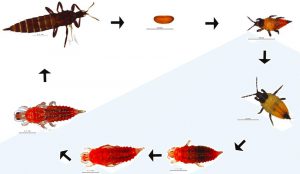Brazilian peppertree (Schinus terebinthifolia) is one of the most wide spread, invasive weeds in Florida. Presently occupying more than 700,000 acres across the state, it’s negative impacts on native flora and fauna are plentiful. As an aggressive, woody weed, Brazilian peppertree forms dense canopies as it matures, smothering native flora, creating inhospitable habitat for wildlife, and altering fire regimes. In addition to decimating our natural ecosystems, this noxious weed has rapidly spread across ranchlands and highway roadsides. Furthermore, as a member of the poison ivy family (Anacardiaceae), handling this plant may result in allergic reactions and respiratory illness. Native to South America, Brazilian peppertree was first introduced to the United States in the mid-19th century for use as… you guessed it, an ornamental plant! It’s attractive, red berries are readily consumed and further dispersed by racoons, possums, and migratory birds.

The Florida Fish and Wildlife Conservation Commission and the South Florida Water Management District spends over $4.7 million every year in an attempt to manage Brazilian peppertree. Over the years, these funds have primarily been allocated for chemical and mechanical control measures. Unfortunately, these traditional methods have failed to disrupt it’s continued spread, remaining costly, labor intensive, and merely providing temporary means of control. Additionally, non-target effects of broad-spectrum chemicals, particularly in fragile ecosystems such as coastal mangrove forests of the Florida Everglades, can significantly increase water pollution and have detrimental affects on wildlife.

With this in mind, researchers in the eastern United States have been evaluating biocontrol options for Brazilian peppertree since the 1950s. To date, there are two insects approved for release here in Florida. Following extensive, rigorous experimental trials, these include the Brazilian peppertree thrips (Pseudophilothrips ichini) and the Brazilian peppertree leaf galler (Calophya latiforceps). Both the larval and adult stages of Brazilian peppertree thrips damage the plant while feeding on vegetative and floral tissue. Most of the damage inflicted on Brazilian peppertree by the leaf galling psyllid (Calophya latiforceps) results from larval feeding and subsequent galling on leaf tissue. Brazilian peppertree thrips were first released in July of 2019 in Brevard, Broward, Collier, Hillsborough, Polk, Miami-Dade, Sarasota, and Saint Lucie counties. Release of the Brazilian peppertree leaf galler is anticipated sometime this year (2021).

Insects from the family Calophyidae are incredibly host-specific. For this reason, scientists at the University of Florida have additionally been evaluating two other species, Calophya lutea and Calophya terebinthifolii, as biocontrol agents for Brazilian peppertree, with successful results. Both species proved host-specific, forming galls and completing their life cycle only on Brazilian peppertree. An integrated pest management program involving the release of host-specific biocontrol agents, coupled with traditional methods of management (chemical, mechanical) could prove efficacious here in Florida.
For more information on Brazilian peppertree and on-going biocontrol efforts, be sure to check out these links:
UF/IFAS Extension: Brazilian peppertree thrips (Psuedophilothrips ichini)
 0
0
